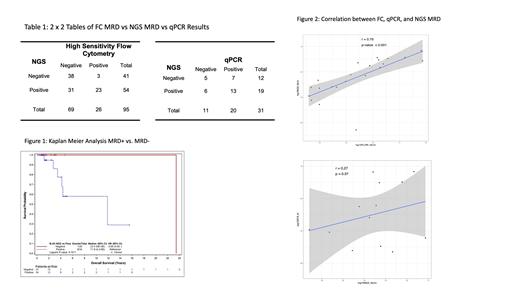Abstract
Introduction: Detection of minimal residual disease (MRD) is one of the most powerful predictors of prognosis in patients with B-Lymphoblastic Leukemia (ALL). Standard methods to detect MRD in ALL include high-resolution flow cytometry (FC) (sensitivity 10 -4 to 10 -5) and qPCR for Ph+ ALL (sensitivity 10 -5 to -6). More recently, high-throughput sequencing (NGS) has been leveraged to detect MRD (sensitivity 10 -6). Retrospective, non-clinical trial based real-world data comparing between these methodologies in the literature is limited to absent. We report our experience at a high-volume cancer center comparing NGS, qPCR, and FC.
Methods: All cases of ALL with NGS MRD data at the Moffitt Cancer Center were identified. Corresponding FC, qPCR (p190 and p210) and clinical data were collected electronically and via chart review.
10-color flow cytometry was performed on a Gallios System and analyzed on Kaluza (Beckman Coulter, IN). 750,000 events were collected on all cells. Validated lower limit of detection was at least 0.01%. Antibodies included CD15, CD130, CD10, CD58, CD22, CD33, CD13, CD123, CD19, CD20, CD45, CD38, CD34, CD81, CD200 (BD, Biolegend, Beckman Coulter).
Quantidex™ BCR-ABL IS Kit (RT qPCR) was used to quantify BCR-ABL (p190 and p210) and ABL transcripts in total RNA in patients with ALL on Applied Biosystems 7500 Fast Dx Real-Time PCR instrument. The results were expressed by normalized BCR-ABL to ABL (control) ratio.
clonoSEQ ® (Adaptive Biotechnologies, Seattle, WA) testing was performed which uses multiplex polymerase chain reaction (PCR) and NGS to identify, characterize, and monitor clonotypes of immunoglobulin (Ig) IgH (V-J), IgH (D-J), IgK, and IgL receptor gene sequences, and translocated BCL1/IgH (J) and BCL2/IgH (J) sequences.
Statistical analysis was performed by Spearman correlation coefficient and Kaplan-Meier analysis.
Results: 95 samples from 54 unique patients were identified that had both NGS and FC data. A subset of patients had qPCR data (n=31 samples). FC+ values ranged from 0.00004 to 0.75. NGS+ values ranged from 8.25E-08 to 0.49. Spearman correlation coefficient showed moderate concordance between NGS and FC at r=0.62 (p<0.001). Spearman correlation coefficient for qPCR vs Flow was r= 0.08 (p=0.68). Three samples were positive by FC (mean tumor burden (MTB= 0.002) but missed by NGS; whereas 31 samples were detected by NGS (MTB= 0.0016) that were missed by flow cytometry. By FC, 9 samples were equivocal of which 7 were definitively designated as MRD+ by NGS. There were 7 qPCR+/NGS- samples (MTB= 2.5 x 10 -5) and 6 qPCR-/NGS+ cases (MTB= 0.012). Overall survival was worse for MRD+ (by NGS, qPCR, or FC) vs MRD(-) (Figure 1).
Conclusion:
Our study confirms the importance of MRD detection in ALL and shows the robust utility of NGS for MRD detection in routine hematopathology practice. While qPCR, FC and NGS are complementary given that each can potentially detect MRD missed by another method, the data supports the increased sensitivity of NGS over FC.
Shah: Servier Genetics: Other; Jazz Pharmaceuticals: Research Funding; Incyte: Research Funding; BeiGene: Consultancy, Honoraria; Acrotech/Spectrum: Honoraria; Pharmacyclics/Janssen: Honoraria, Other: Expenses; Kite, a Gilead Company: Consultancy, Honoraria, Other: Expenses, Research Funding; Precision Biosciences: Consultancy; Amgen: Consultancy; Pfizer: Consultancy, Other: Expenses; Novartis: Consultancy, Other: Expenses; Bristol-Myers Squibb/Celgene: Consultancy, Other: Expenses; Adaptive Biotechnologies: Consultancy. Hussaini: Stemeline Therapeutics: Honoraria.


This feature is available to Subscribers Only
Sign In or Create an Account Close Modal